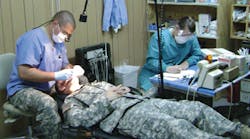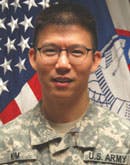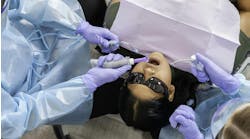By Major Min C. Kim, DDS
This month, Dental Economics salutes our soldiers, veterans, and all others who have made sacrifices for our freedom. Here we take the time to recognize one of those individuals, a fellow dentist, Major Eric Danko, DMD.
Eric Danko became interested in dentistry when he was in college. While a student, he was excited to find a dentist near his college who would talk with him about a future in dentistry. It turned out that the local dentist had served in the U.S. Army and had funded his dental degree using the Army's Health Professions Scholarship Program (HPSP).
Danko looked into the HPSP program. At first, he was apprehensive because neither he nor his family had military experience. However, the thought of the Army financing his dental education in exchange for his service as a dental officer was appealing.
RELATED | Male dental assistant enjoys profession, military career
Major Eric Danko, DMD, earned his dental degree from the University of Kentucky in 2004. The HPSP provided him with tuition, a monthly stipend, and money to buy books and equipment. Today, he is a comprehensive dentist. He has deployed twice to Iraq and currently serves as a Dental Corps Professional Development Officer, U.S. Army Human Resources Command, Fort Knox, Kentucky.
During his first deployment, he was part of the 257th Medical Company, Fort Bragg, North Carolina, stationed in Iraq's Green Zone. There, he was part of the unit that set up in the dental clinic that was used by Saddam Hussein at Ibn Sina Hospital.
The dental equipment he used in Iraq was modern. Hours were regular, normally from 8 a.m. to 4 p.m., Monday through Saturday. He would see 10 to 15 patients per day. Root canal treatments and either amalgam or composite fillings were common procedures. Danko was surprised, however, that the most common procedure was esthetic repair of the upper and lower incisors, which occurred as a result of combat. He also found that it was a great opportunity to become proficient in third molar extractions.
"The deployment was fantastic," said Danko. "I got there in August 2004, and I was there for five months. However, when I got back, I wanted to leave the military because I was angry that I was deployed so quickly after reporting to Fort Bragg. So, I bought a 'countdown' clock, but it only went to 999 days, and I had around 1,060 days left in service. As I was waiting to use that clock, I changed my mind about getting out."
Danko realized that he preferred treating soldiers to treating civilians while he was moonlighting, working only one day a week in South Carolina. "Soldiers are so appreciative," Danko said. "For example, a civilian might sit down and ask, 'How long is this going to take? I have an appointment.' But I have actually had soldiers in the chair for five hours, without complaining about how long it took."
Danko says that soldiers would listen and would be willing to follow his advice. With soldiers, he could focus on providing quality treatment with less pressure on time. Moreover, soldiers tend to have fewer medical complications that affect dental treatment.
After some thought, he decided to stay in the Army and continue to pursue his goals. Among these goals was earning the Airborne Badge, which led him to join the 82nd Airborne Division as the brigade dentist. He then deployed to Iraq for a second time.
His second deployment was more dangerous. He was in a situation that required treating soldiers where aero-medical evacuation wasn't always possible. He was the only dentist for 3,000 soldiers and worked from 8 a.m. to 8 p.m., seven days a week. The most common dental procedures were exams and sick calls. If he had dental questions, he went online to ask an on-call Army dental specialist.
RELATED | Deployed dentistry
Through each of his deployments and the interval between them, Danko ultimately discovered how much he loved general dentistry. He decided to pursue the Army's two-year Advanced Education in General Dentistry program. Through this program, he became a board-certified comprehensive dentist at Fort Bragg, North Carolina.
Dr. Danko's intent is to continue his career in the Army for as long as he feels great about going to work. He is now stationed in Fort Knox, Kentucky, as a Dental Corps liaison who assists with the Army's Dental Recruiting Mission. In the future, he plans to spend time with his twin seven-year-old boys and pursue other hobbies, such as running marathons and mentoring junior officers. His career aspirations include assuming a command position, providing quality dental care to soldiers, and sharing his experiences.







